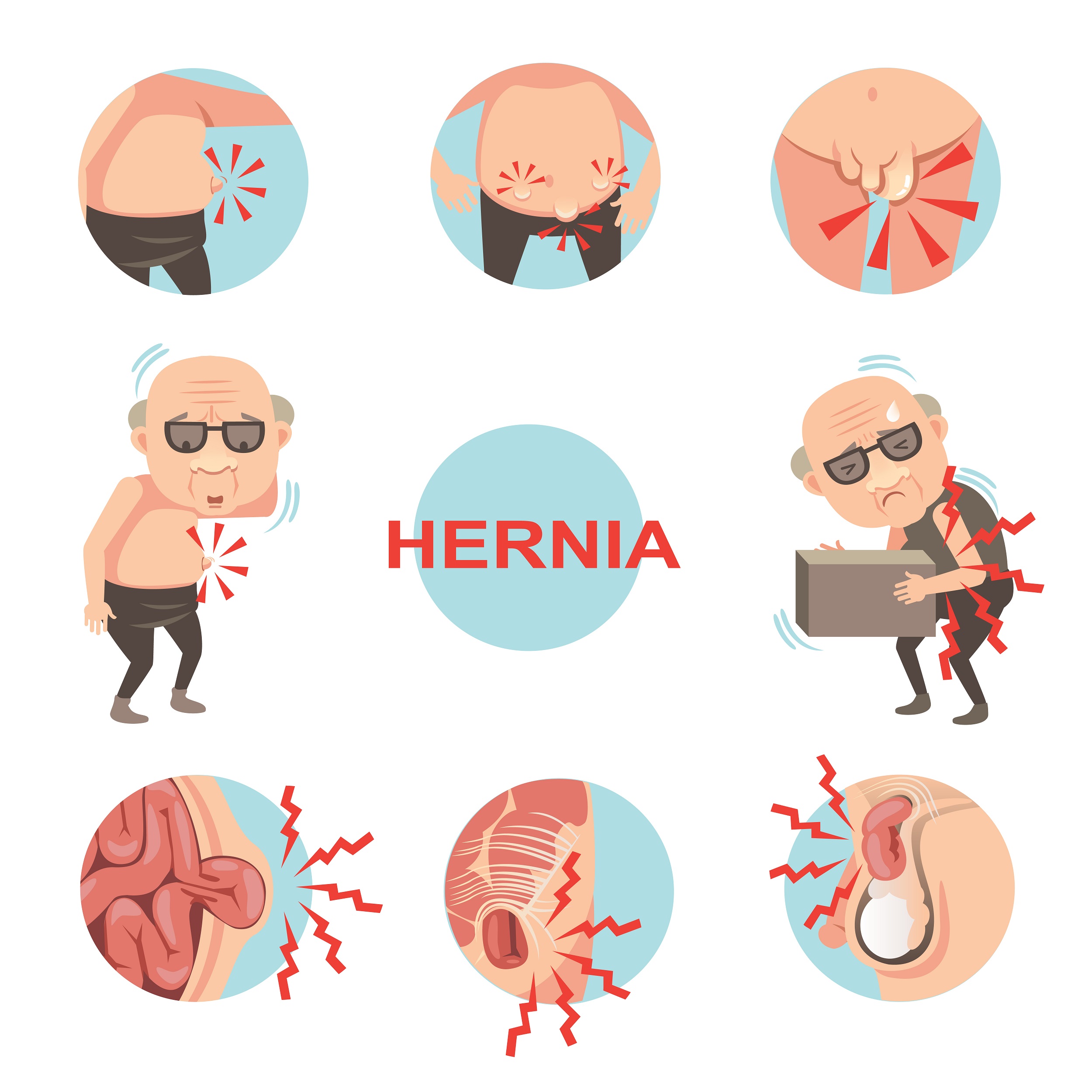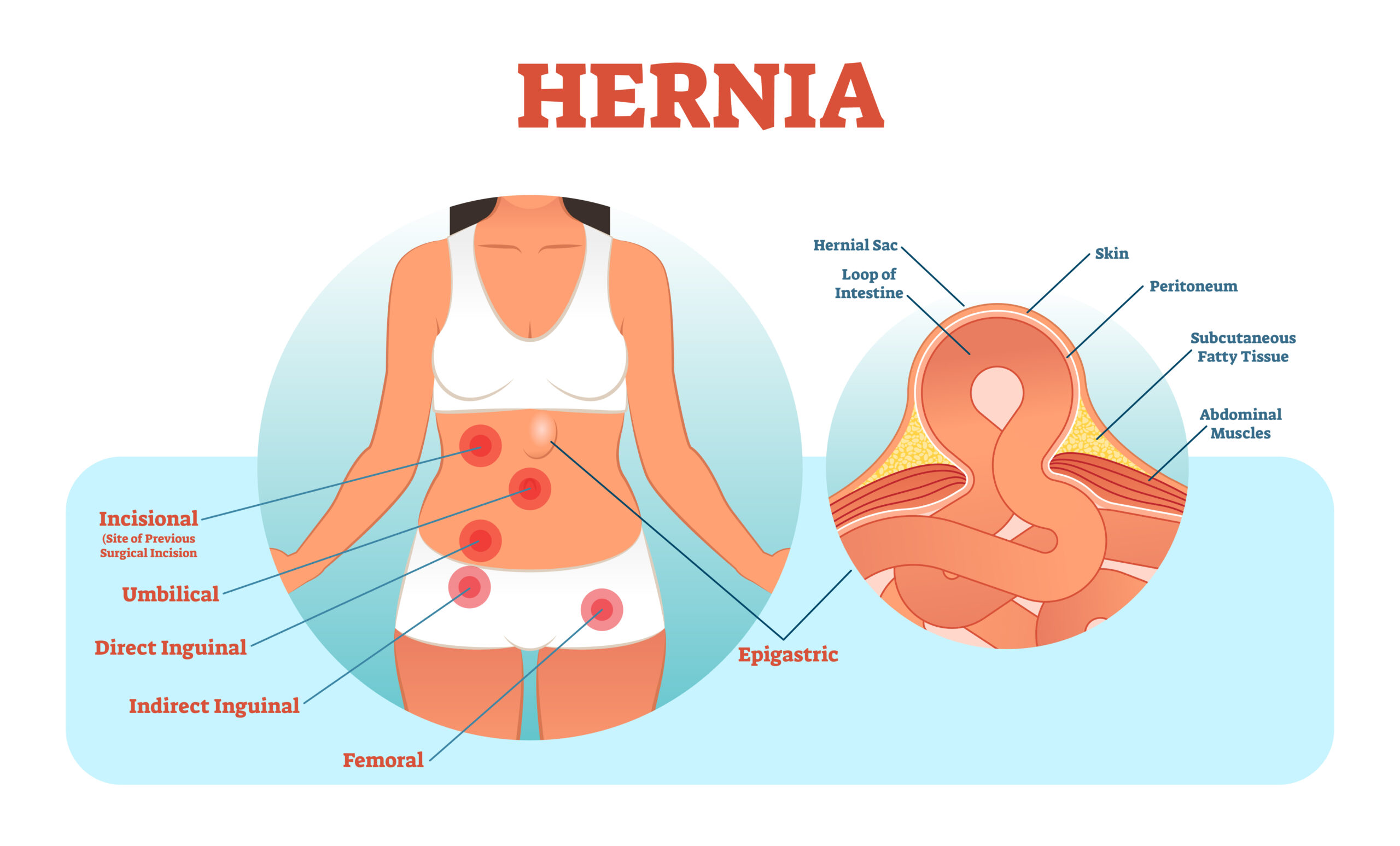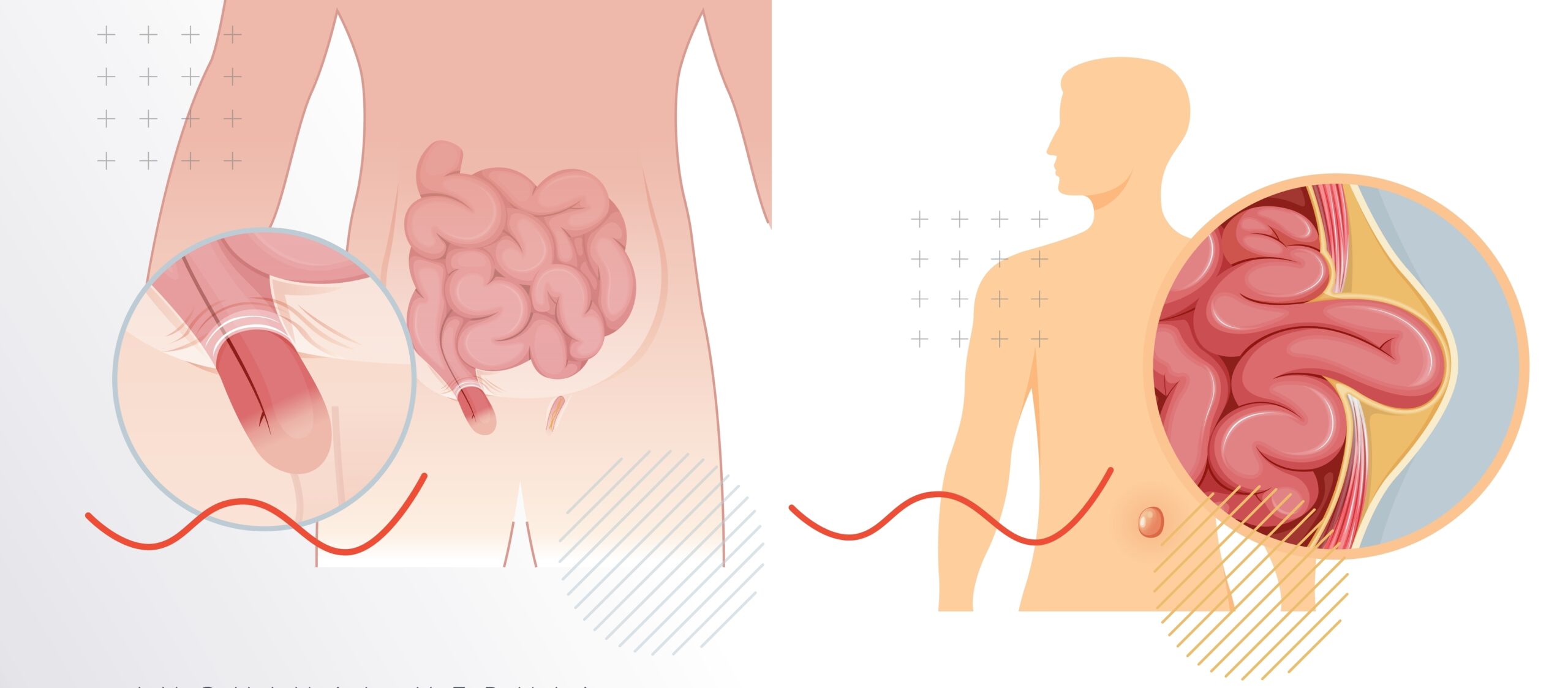Untreated Hernias are More Dangerous Than You Think!
Hernia is a condition where internal organs within the abdominal cavity move through an abnormal passage to another location. Commonly found organs include the bowel and omentum, a fatty apron of tissue that hangs over the intestine. As for the abnormal passage, it may be a natural opening that should close on its own at birth or could develop later on. This can occur anywhere from the diaphragm down to the groin. Patients often feel a lump in the affected area. If left untreated, there is a risk that the displaced organ may become trapped in the abnormal passage, a condition known as an incarcerated hernia, leading to dangerous complications such as bowel obstruction or strangulated hernia, necessitating emergency surgical intervention.
 Dr. Nattaporn Nuanuthai, our general surgeon at Bangkok Hospital Hua Hin, shares that hernias can occur in individuals of all genders and ages, but they are more commonly found in males than females. In children, hernias often develop from birth and are associated with a natural opening that closes later than usual or in premature infants. In contrast, adults frequently experience hernias later in life, with risk factors such as increased abdominal pressure due to chronic coughing from lung disease, chronic bronchitis, or chronic obstructive pulmonary disease (COPD), regular heavy lifting, strenuous physical activity, constipation, enlarged prostate, obesity, pregnancy, and conditions involving fluid in the abdominal cavity, such as liver disease.
Dr. Nattaporn Nuanuthai, our general surgeon at Bangkok Hospital Hua Hin, shares that hernias can occur in individuals of all genders and ages, but they are more commonly found in males than females. In children, hernias often develop from birth and are associated with a natural opening that closes later than usual or in premature infants. In contrast, adults frequently experience hernias later in life, with risk factors such as increased abdominal pressure due to chronic coughing from lung disease, chronic bronchitis, or chronic obstructive pulmonary disease (COPD), regular heavy lifting, strenuous physical activity, constipation, enlarged prostate, obesity, pregnancy, and conditions involving fluid in the abdominal cavity, such as liver disease.
 Types of Hernias
Hernias come in various types depending on their location, including:
Types of Hernias
Hernias come in various types depending on their location, including:
 Symptoms and Diagnosis of Hernias:
The symptoms of hernias typically manifest in the affected area, starting with discomfort or mild pain. A soft lump may be felt and can sometimes be pushed back when coughing or sneezing. The lump may disappear when lying flat, but if it persists, it can become trapped and not recede. Warning signs of severe complications include persistent pain in the hernia area, inability to push the hernia back, abdominal pain, bloating, vomiting or unable to pass gas or stool. Patients with suspected complications should seek medical attention immediately.
For diaphragmatic hernias, symptoms can vary. Patients may experience sensations such as chest tightness resembling acid reflux, difficulty breathing, or a feeling of swallowing challenges.
The diagnosis of hernias depends on the location of the abnormal passage of the hernia. If it’s in the anterior abdominal wall, a physical examination by a doctor may be sufficient. For hernias in deeper locations or cases with a thick abdominal wall, additional diagnostic tests such as ultrasound or CT scan may be necessary for diagnosis.
Symptoms and Diagnosis of Hernias:
The symptoms of hernias typically manifest in the affected area, starting with discomfort or mild pain. A soft lump may be felt and can sometimes be pushed back when coughing or sneezing. The lump may disappear when lying flat, but if it persists, it can become trapped and not recede. Warning signs of severe complications include persistent pain in the hernia area, inability to push the hernia back, abdominal pain, bloating, vomiting or unable to pass gas or stool. Patients with suspected complications should seek medical attention immediately.
For diaphragmatic hernias, symptoms can vary. Patients may experience sensations such as chest tightness resembling acid reflux, difficulty breathing, or a feeling of swallowing challenges.
The diagnosis of hernias depends on the location of the abnormal passage of the hernia. If it’s in the anterior abdominal wall, a physical examination by a doctor may be sufficient. For hernias in deeper locations or cases with a thick abdominal wall, additional diagnostic tests such as ultrasound or CT scan may be necessary for diagnosis.
 Treatment of Hernias:
Currently, the primary treatment for hernias is surgery. Treatment without surgery involves closely monitoring symptoms and providing cautious symptom-specific care, and it is applicable only to certain patients. The standard surgical approach involves repairing hernias by using surgical mesh to enhance strength and reduce recurrence rates. There are two main techniques:
Treatment of Hernias:
Currently, the primary treatment for hernias is surgery. Treatment without surgery involves closely monitoring symptoms and providing cautious symptom-specific care, and it is applicable only to certain patients. The standard surgical approach involves repairing hernias by using surgical mesh to enhance strength and reduce recurrence rates. There are two main techniques:
 Dr. Nattaporn Nuanuthai, our general surgeon at Bangkok Hospital Hua Hin, shares that hernias can occur in individuals of all genders and ages, but they are more commonly found in males than females. In children, hernias often develop from birth and are associated with a natural opening that closes later than usual or in premature infants. In contrast, adults frequently experience hernias later in life, with risk factors such as increased abdominal pressure due to chronic coughing from lung disease, chronic bronchitis, or chronic obstructive pulmonary disease (COPD), regular heavy lifting, strenuous physical activity, constipation, enlarged prostate, obesity, pregnancy, and conditions involving fluid in the abdominal cavity, such as liver disease.
Dr. Nattaporn Nuanuthai, our general surgeon at Bangkok Hospital Hua Hin, shares that hernias can occur in individuals of all genders and ages, but they are more commonly found in males than females. In children, hernias often develop from birth and are associated with a natural opening that closes later than usual or in premature infants. In contrast, adults frequently experience hernias later in life, with risk factors such as increased abdominal pressure due to chronic coughing from lung disease, chronic bronchitis, or chronic obstructive pulmonary disease (COPD), regular heavy lifting, strenuous physical activity, constipation, enlarged prostate, obesity, pregnancy, and conditions involving fluid in the abdominal cavity, such as liver disease.
 Types of Hernias
Hernias come in various types depending on their location, including:
Types of Hernias
Hernias come in various types depending on their location, including:
- Inguinal Hernias: Occur in the groin area, commonly found in males. In severe cases, it may descend into the scrotum (Scrotal Hernia).
- Umbilical Hernias: Located around the navel, common in children, results from the incomplete closure of the abdominal wall near the navel. It often resolves as the abdominal wall strengthens.
- Incisional Hernias: Develop in individuals who have previously undergone abdominal surgery. Weakness in the repaired area causes protrusion of internal organs through the incision site.
- Ventral Hernias: Spontaneously occurs in weakened abdominal wall areas, allowing internal organs to protrude. Have various names based on their location, such as Spigelian Hernia or Epigastric Hernia.
- Femoral Hernias: Less common but more prevalent in females, occurring in the femoral canal below the level of the inguinal ligament.
- Obturator Hernias: Rare but severe, often leading to bowel obstruction. Diagnosis is challenging and may require imaging such as a CT scan. Typically found in older, slender women.
- Diaphragmatic Hernias: Result from abnormal openings in the diaphragm, causing abdominal organs to move into the chest cavity. Can be congenital or occur after trauma to diaphragm.
 Symptoms and Diagnosis of Hernias:
The symptoms of hernias typically manifest in the affected area, starting with discomfort or mild pain. A soft lump may be felt and can sometimes be pushed back when coughing or sneezing. The lump may disappear when lying flat, but if it persists, it can become trapped and not recede. Warning signs of severe complications include persistent pain in the hernia area, inability to push the hernia back, abdominal pain, bloating, vomiting or unable to pass gas or stool. Patients with suspected complications should seek medical attention immediately.
For diaphragmatic hernias, symptoms can vary. Patients may experience sensations such as chest tightness resembling acid reflux, difficulty breathing, or a feeling of swallowing challenges.
The diagnosis of hernias depends on the location of the abnormal passage of the hernia. If it’s in the anterior abdominal wall, a physical examination by a doctor may be sufficient. For hernias in deeper locations or cases with a thick abdominal wall, additional diagnostic tests such as ultrasound or CT scan may be necessary for diagnosis.
Symptoms and Diagnosis of Hernias:
The symptoms of hernias typically manifest in the affected area, starting with discomfort or mild pain. A soft lump may be felt and can sometimes be pushed back when coughing or sneezing. The lump may disappear when lying flat, but if it persists, it can become trapped and not recede. Warning signs of severe complications include persistent pain in the hernia area, inability to push the hernia back, abdominal pain, bloating, vomiting or unable to pass gas or stool. Patients with suspected complications should seek medical attention immediately.
For diaphragmatic hernias, symptoms can vary. Patients may experience sensations such as chest tightness resembling acid reflux, difficulty breathing, or a feeling of swallowing challenges.
The diagnosis of hernias depends on the location of the abnormal passage of the hernia. If it’s in the anterior abdominal wall, a physical examination by a doctor may be sufficient. For hernias in deeper locations or cases with a thick abdominal wall, additional diagnostic tests such as ultrasound or CT scan may be necessary for diagnosis.
 Treatment of Hernias:
Currently, the primary treatment for hernias is surgery. Treatment without surgery involves closely monitoring symptoms and providing cautious symptom-specific care, and it is applicable only to certain patients. The standard surgical approach involves repairing hernias by using surgical mesh to enhance strength and reduce recurrence rates. There are two main techniques:
Treatment of Hernias:
Currently, the primary treatment for hernias is surgery. Treatment without surgery involves closely monitoring symptoms and providing cautious symptom-specific care, and it is applicable only to certain patients. The standard surgical approach involves repairing hernias by using surgical mesh to enhance strength and reduce recurrence rates. There are two main techniques:
- Open Surgery: A traditional open incision to repair or reinforce the weakened area and apply external surgical mesh. Recovery time and postoperative pain may be longer. However, there are advantages for patients with limitations in general anesthesia. This surgical technique can be performed under local or regional anesthesia.
- Laparoscopic Surgery: This minimally invasive procedure uses small incisions and a camera to repair the hernia with internal mesh. Advantages include quicker recovery and reduced postoperative pain compared to open surgery, allowing patients to return to normal activities sooner. Currently, surgery using this technique is becoming the standard treatment for hernia surgery. However, this method may have limitations for patients who cannot tolerate anesthesia by inhalation. For those with a history of abdominal surgery or large hernias, it is advisable to consult with a surgeon to plan a suitable and safe surgical approach.